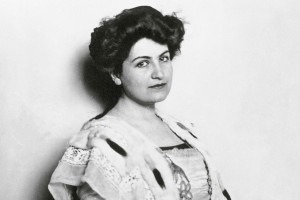
Manon Gropius with her parents Alma Mahler and Walter Gropius, 1918
Berg was inspired into writing by the death of the daughter of Alma Mahler and Walter Gropius, Manon (1916-1935).
Alma and Walter, married in 1915 and separated in 1918 after Alma discovered Franz Werfel and Walter discovered who the father of his fourth child was. Manon spent her childhood with her mother and from as early as 5 years old, began her life in acting. After her parent’s divorce, finally, in 1927, Manon could reestablish communication with father who often hid his letters to her in gift books and magazines so that Alma wouldn’t find them.

Alma Mahler
Hardly a moment later a gazelle came tripping into the room, a light-footed, brown-haired creature disguised as a young girl, untouched by the splendor into which she had been summoned, younger in her innocence than her probable sixteen years. She radiated timidity even more than beauty, an angelic gazelle, not from the ark but from heaven.

Manon Gropius and a Siamese cat
Alban Berg and his wife Helene were long-standing family friends and Berg took Manon’s life as the inspiration for his Violin Concerto, putting the reference in the title: “To the Memory of an Angel.”
The concerto is in 2 parts, and each part is further divided into two parts, giving an overall structure of birth, life, death, and transfiguration (Andante – Allegretto – Allegro – Adagio). The Andante begins very softly with rising motions in the woodwind and harp and violin. The Allegretto (05:04) begins with a clarinet theme that is shared with the violin. This dance-like Scherzo is interrupted by a contrasting Trio (06:59) that changes the hitherto languid writing to something more urgent. The Trio section is then interrupted by a folk song from Carinthia (10:39) played by the solo violin and horn. The introduction of this little tonal folk song in this serial work is almost shocking.
Berg: Violin Concerto “To the Memory of an Angel”: I. Andante: Allegretto (Anne-Sophie Mutter, violin; Chicago Symphony Orchestra; James Levine, cond.)
The second movement begins with an Allegro and here we have the reflection of the suffering of the paralyzed Manon – eventually a death-march rhythm pushes us to the end of this section, with violin taking Manon’s screams for help (06:30). The last section, Adagio (07:30), returns to the front of redemption: a Bach chorale, “Es ist genug,” from Chorale No. 60, with the woodwinds sounding like a small organ. To finish, the violin soars into a figurative heaven.
II. Allegro : Adagio
It’s an amazing work that, in the idiom of serialism that sometimes holds listeners at a distance, is able to sweep up the listener and take them away, in the end, from the troubles of earth and the pains of daily life. The death of a beautiful eighteen-year-old, just on the cusp of making her new life, was truly inspirational.

